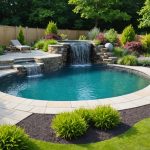Understanding Thermal Bridging
In the realm of energy efficiency, thermal bridging is a major consideration, especially in UK post-war homes. But what is thermal bridging? Simply put, it’s a path that allows heat to escape more easily through parts of a building, often through structural elements such as walls and roofs. This is particularly prevalent in post-war terraced homes, where construction materials from that era were not as advanced in thermal resistance as modern options.
Why is this an issue? Thermal bridging leads to significant energy loss, making heating these homes more challenging and costly. Though seemingly minor, these bridges can lead to substantial heat leakage, increasing heating bills and energy consumption.
A lire aussi : Top Flooring Solutions for UK Homes: Ideal Choices for Pets and High Traffic Areas
This has broader implications beyond just financial costs. Minimising thermal bridging is vital in reducing carbon emissions, an essential goal in the face of climate change. By improving the insulation and addressing these energy ‘leaks,’ homeowners can enhance the energy efficiency of their properties, ultimately contributing to a decrease in environmental impact.
Addressing thermal bridging is crucial for both economic and ecological reasons, and understanding its impact can guide effective upgrades to the energy performance of homes.
A lire aussi : Step-by-Step Guide: Securing Approval for Exterior Painting of UK Listed Buildings
Identifying Thermal Bridging Areas
When tackling energy inefficiency in post-war terraced homes, it’s essential to focus on areas prone to thermal bridging. These homes often experience this issue around connecting walls, corners, and junctions of different building elements. Corners and roof eaves are particularly problematic due to inadequate insulation and structural mismatches.
To effectively detect thermal bridging, methods such as thermal imaging and comprehensive energy audits come into play. Thermal imaging cameras can highlight cold spots on walls that represent potential thermal bridging zones. Triangulating this with data from energy audits gives homeowners a clearer thermal map of their property. For precise thermal bridging detection, the expertise of a professional is invaluable.
Homeowners, while encouraged to perform preliminary checks, should work closely with professionals to diagnose the home’s thermal performance effectively. These experts can offer insights through in-depth analyses and recommend appropriate remediation measures.
Identifying these building fabric vulnerabilities early on can significantly enhance thermal efficiency. Ultimately, this proactive approach saves energy and improves comfort. By addressing these common thermal bridging hotspots, homeowners ensure a more energy-efficient and resilient dwelling.
Effective Insulation Strategies
When it comes to insulation solutions, especially in retrofitting post-war homes, choosing the right thermal insulation is crucial. These buildings often have unique challenges due to their age and the materials initially used. A commonly recommended approach is the use of building materials like mineral wool or rigid foam boards. These materials offer excellent thermal properties and can significantly reduce energy loss.
Case Studies and Techniques
One notable case study involved a 1950s residential block where external thermal insulation minimised thermal bridging without altering the building’s original facade. This approach, using high-performance materials like aerogel blankets, demonstrated how modern techniques can enhance the efficiency of older buildings.
Another effective method includes cavity wall insulation, which adds an insulating layer between the walls’ two main layers. This technique is particularly useful in post-war homes with cavity walls.
Balancing Insulation with Compliance
Insulating older homes must balance effectiveness with regulatory compliance in the UK. The insulation project must meet the UK’s Building Regulations, which ensures not only energy efficiency but also safety standards are upheld. Properly executed projects enhance home comfort while adhering to legal stipulations.
By examining these strategies and examples, homeowners can make informed decisions on how best to implement insulation solutions within existing structures.
Role of Ventilation in Reducing Thermal Bridging
Home ventilation plays a crucial role in maintaining a comfortable living environment while supporting insulation efforts. Proper airflow management ensures that moist air doesn’t get trapped, reducing the risk of dampness and condensation, which are common issues with insufficient ventilation. Without adequate ventilation, even the best-insulated homes can suffer from poor air quality and condensation problems.
Understanding and implementing effective ventilation strategies can significantly enhance insulation performance. Strategies such as mechanical ventilation with heat recovery (MVHR) can complement insulation by efficiently managing air exchange. This system recovers energy from exhausted air and uses it to preheat incoming fresh air, reducing the energy required to maintain comfortable temperatures.
Energy recovery ventilation systems (ERV) also offer notable benefits by balancing airflow and maintaining desired humidity levels, which is especially beneficial in colder climates. Unlike standard ventilation systems, ERVs recover both heat and humidity, providing a more consistent indoor climate.
Some benefits of energy recovery ventilation systems include:
- Enhanced indoor air quality
- Reduced energy consumption
- Minimized condensation risks
- Improved overall comfort
By integrating these systems, homeowners can effectively manage airflow and support energy efficiency, reducing the chance of thermal bridging and enhancing overall building performance.
Cost Considerations for Retrofitting
When planning a retrofit, budget planning becomes vital due to the numerous factors impacting retrofit costs. The initial cost might seem daunting, but understanding the elements can aid better financial decisions.
Breakdown of Costs
Retrofit costs vary based on the chosen methods for reducing thermal bridging. Common expenses include material costs, labour, and potential disruptions during installation. Methods like adding insulation, replacing windows, or using thermal breaks each have distinct cost implications. It’s essential to consider not only the upfront costs but also potential savings.
Investment vs. Long-term Savings
While the upfront cost might be significant, the cost-effectiveness of retrofitting lies in long-term benefits. Energy savings can gradually offset the initial investment, lowering utility bills over time. Investment in cost-effective methods can provide a balance between quality and future savings, ensuring a sound investment over time.
Financial Support in the UK
Homeowners in the UK can explore financial incentives or grants designed to support energy efficiency upgrades. These incentives can ease the financial burden, making retrofitting a more accessible option. Governments and environmental groups often provide programs to encourage eco-friendly improvements, further supporting budget planning for such projects.
Regulatory Considerations and Compliance
Navigating the realm of Building Regulations and Compliance Standards in the UK requires understanding critical elements, especially those centered on thermal performance. Adhering to Energy Efficiency Regulations involves ensuring that residential properties achieve and maintain optimal insulation levels. This is not only a regulatory requirement but also contributes significantly to reducing energy consumption and environmental impact.
To meet these standards, property owners must implement effective strategies to enhance their home’s thermal performance. This might involve installing insulation materials, upgrading windows to double or triple glazing, and using energy-efficient heating systems. Meeting Compliance Standards often necessitates hiring qualified professionals. These experts ensure all modifications adhere to current legal standards, providing the necessary documentation and expertise to avoid potential legal pitfalls.
Improving energy efficiency in homes is crucial, since it often results in lower utility bills and a reduced carbon footprint. Employing certified professionals guarantees that all work conforms to the latest Building Regulations, offering peace of mind and safeguarding your investment. Ignoring these regulations not only risks legal repercussions but may also lead to costly corrections in the future, as non-compliance with Building Regulations can have significant financial and environmental consequences.
Challenges in Implementation
The process of tackling thermal bridging in homes often poses significant retrofitting challenges. Homeowners and contractors face various implementation issues that require careful consideration and strategic planning. The primary hurdle is identifying the presence of thermal bridges, which can be hidden within the structure and lead to energy inefficiency. Accurate detection is crucial to prevent future issues such as increased energy bills or discomfort caused by temperature fluctuations.
To overcome these obstacles, contractors often utilise advanced thermal imaging technology, allowing them to pinpoint problem areas without intrusive inspections. This proactive approach not only saves time but also minimises disruption to the homeowner.
A key element in successful retrofitting projects is fostering effective stakeholder collaboration. Ensuring that homeowners and construction professionals engage in open communication can alleviate many concerns. Homeowner concerns generally revolve around project costs, timelines, and the potential disruption to day-to-day activities. Regular updates and clear communication help build trust and ensure that expectations are managed appropriately.
Moreover, practical tips like scheduling work during periods of lower household activity, setting realistic timelines, and offering transparent cost estimates can ease the retrofitting process. By addressing these issues head-on, the path to improving home energy efficiency becomes clearer and more effective.











